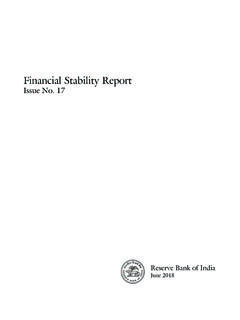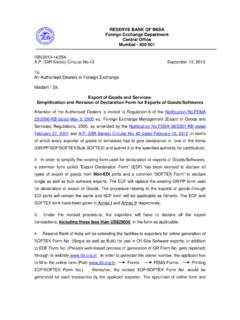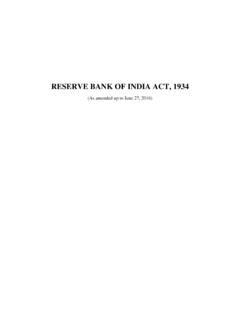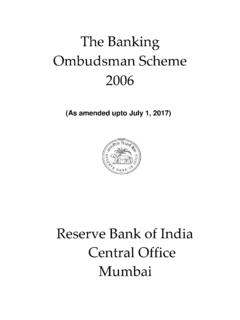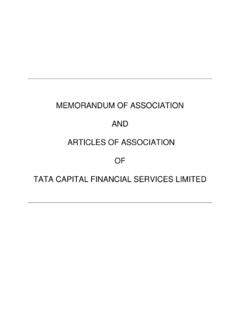Transcription of FinTech: The Force of Creative Disruption*
1 ARTICLERBI Bulletin November 202075 fintech : The Force of Creative DisruptionFinTech has the potential to fundamentally transform the financial landscape, provide consumers with a greater variety of financial products at competitive prices, and help financial institutions become more efficient. The rapid and transformational changes brought on by fintech need to be monitored and evaluated so that regulators and society can keep up with the underlying technological and entrepreneurial flux. This article provides a succinct review of the sector, encompassing its evolution, characteristics and driving factors, both for the world and India. For a sustainable business ecosystem, FinTechs need to bridge the digital divide and promote equitable and broad-based customer participation. Introduction The landscape of banking and financial sector has undergone a phenomenal transformation since 2008 Global Financial Crisis (GFC), owing to financial technology firms, popularly known as FinTechs.
2 Both as Creative disruptors and facilitators, FinTechs have contributed to the modern banking and financial sector through various channels including cost optimisation, better customer service and financial inclusion. FinTechs have played an important role in unbundling banking into core functions of settling payments, performing maturity transformation, sharing risk and allocating capital (Carney, 2019). The information and telecommunications (IT) revolution is regarded as the fifth Technological Revolution driving growth1, and fintech is at the helm of this Creative disruption (Hendrikse et al., 2018). The scope of operations of FinTechs has also broadened, moving from crypto assets to payments, insurance, stocks, bonds, peer to peer lending, robo-advisors, regtech and suptech. In India, FinTechs and digital players could function as the fourth segment of the Indian financial system, alongside large banks, mid-sized banks including niche banks, small finance banks, regional rural banks and cooperative banks (Das, 2020).
3 This segment has the potential to fundamentally transform the financial landscape where consumers will be able to choose from broader set of alternatives at competitive prices, and financial institutions could improve efficiency through lower costs. India has emerged as the fastest growing fintech market and the third largest fintech ecosystem in the world (Mankotia, 2020). Today, we carry out complex financial actions like sending or receiving money, paying bills, buying goods and services , purchasing insurance, trading on stock markets, opening bank accounts and applying for personal loans online using smartphones, without ever physically interfacing with a bank employee. India has the opportunity of a digital payments market of $ 1 trillion (PIB, 2018). It recorded 3,435 crore digital payments in the year 2019-20 (Annex 1).
4 The exciting, rapid and transformational changes in financial services brought on by FinTechs need to be continuously monitored and evaluated so that regulators and society can keep up with the underlying technological and entrepreneurial flux. Regulators need to be Creative , nimble and tech savvy with their approach. They will have to further expand their focus from entities to activities, while also becoming experts in assessing the soundness and security of algorithms, which is easier said than done (Lagarde, 2017). Thus, for facilitating discussion and understanding that could be useful for policy and regulation purposes, this article attempts to provide a succinct review of FinTechs, encompassing their evolution, fintech : The Force of Creative Disruption** This article is prepared by Rajas Saroy, Ramesh Kumar Gupta and Sarat Dhal, Department of Economic and Policy Research, Reserve Bank of India.
5 The authors are thankful to Smt. Rekha Misra and Dr. Mohua Roy for their valuable comments and guidance. The views expressed are those of the authors and do not necessarily reflect the views of the Reserve Bank of The five Technological Revolutions defined by Perez (2002) are the Industrial Revolution, The Age of Steam and Railways, The Age of Steel, Electricity and Heavy Engineering, The Age of Oil, Automobiles and Mass Production and, The Age of Information and Communications. ARTICLERBI Bulletin November 202076 fintech : The Force of Creative Disruptioncharacteristics and driving factors. Our evaluation throws up sobering concerns regarding the future of FinTechs, such as the status of digital hygiene, data use and privacy. The article proceeds in five sections: the fintech revolution in the global context, delving into its history, evolution, and adoption in Section II, the fintech ecosystem in India, its enablers, diversity, funding and collaboration with banks in Section III, challenges for future development in Section IV, and the way forward in Section fintech Revolution: The Global ContextDefinition of fintech With no universally agreed upon definition, fintech is generally described as an industry that uses technology to make financial systems and the delivery of financial services more efficient.
6 It is technologically enabled financial innovation that could result in new business models, applications, processes or products with an associated material effect on financial markets and institutions and the provision of financial services (FSB, 2019). FinTechs are start-ups and other companies that use technologies (Table 1) to conduct the fundamental functions provided by financial services , impacting how consumers store, save, borrow, invest, move, pay, and protect money (McKinsey, 2016). In today s app-centric world, consumers are less concerned about receiving all their services from a single provider, and instead expect a seamless experience. FinTechs are realising this new value expectation and have started to unbundle many of the traditional financial offerings (Basole and Patel, 2018). At the same time, the financial services provided by FinTechs are being re-bundled with a range of non-financial services , thereby allowing services to be provided seamlessly via application software (Bank of Japan, 2018).
7 Illustratively, taxi aggregators bundle ride sharing with instantaneous fare payment upon arrival at destination. fintech History and Evolution Technology-induced financial innovation has a long history. In the 1950s, credit cards appeared for the first time, followed by Automated Teller Machines (ATMs) in the 1960s, electronic stock trading and banks new data recording systems in 1970s and 1980s, and e-commerce and online brokering in 1990s (Basole and Patel, 2018). The online revolution in the last decade of the 20th century connected the world through the Internet, and enabled e-commerce, Internet banking and pioneering online payment platforms like PayPal. The next decade witnessed the emergence of smart technology. The smartphone materialised as a powerful computer in human Table 1 : Key Enabling Technologies used by FinTechsTechnologyDescriptionAPI (Application Programming Interface)APIs comprise a set of rules and specifications that software programmes use to communicate with each other.
8 They allow new applications to be built on top of ComputingThe use of an online network ( cloud ) of hosting processors to increase the scale and flexibility of computing capacity, generating cost study of distinctive and measurable human characteristics that can be used to categorize and identify (Distributed Ledger Technology)A digital system for recording the transaction of assets in which details are recorded in multiple places at the same time. Big DataVoluminous amounts of structured or unstructured data that can be generated, analysed and utilized by digital tools and information systems. AI (Artificial Intelligence) & ML (Machine Learning)IT systems that can perform functions that would otherwise require human capabilities. ML entails computers learning from data without human intervention. ARTICLERBI Bulletin November 202077 fintech : The Force of Creative Disruptionpalms, and the movement to app-based operating systems spurred innovation, unbundling and sharing of services .
9 Bitcoin came as another important development in 2009. The present decade is dedicated to the rise of the robots , where the emergence of big and unconventional datasets has enabled AI to provide accurate predictions and personalise banking (King, 2019). The new fintech sector gained momentum in its modern incarnation after the GFC as fintech entrepreneurs realised that banking services should be transparent, facilitative and economical (Hendrikse et al., 2018). After the GFC, public perception of banks had deteriorated, as savings were diverted to subprime borrowing without adequate consumer protection. Many finance professionals confronted job losses or pay cuts, which inspired enterprising innovation as FinTechs (Buckley et al., 2016). Also, tighter regulation of traditional banking after GFC supported the growth of the fintech sector (Cortina et al.)
10 , 2018). At present, FinTechs are diversifying into different sectors (Chart 1). Among the top 100 FinTechs, payment and lending companies are being replaced by wealth and brokerage, insurance and multi-sector companies2 (KPMG, 2019).Demand-side Push to fintech Adoption Against the backdrop of globalisation and digitisation, users appetite for financial services has become increasingly diversified and sophisticated in line with their changing lifestyles. The rate of fintech adoption is greater in jurisdictions where there is unmet demand for financial services , less competition from traditional finance, macroeconomic conditions are conducive, regulation is accommodative and demographics are favourable (Frost, 2020). According to the Global fintech Adoption Index 2019 , the adoption of fintech services globally has progressed from 16 per cent in 2015 to 33 per cent in 2017 and 64 per cent in 2019.
